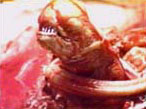

When the embryo has completed it's period of development inside of the host, it emerges into the next stage in it's life. The burster has built up enough strength into order to tear out of the body cavity inside of the host. The host experiences a great deal of pain during this procedure, resulting in convulsions and loss of all rational thought. This process usually results in the death of the host, which in all practical means isn't all the greatest of way to ensure the reproduction of the species. It would be more efficient if the host were reusable for many aliens, but due to the aliens violent nature, it is only fitting for it to cause death upon birth.
Once free of the host, the chestburster is independent to live on it's own. About two feet long from head to tail, it can emerge at different stages of development depending on host conditions, environment, and strength. Unlike the burster seen in 'Alien', the one in 'Aliens' had arms, while the latter was merely a head and tail. Once again the chestburster seen in 'Alien3' was also different; it was more "mature looking" immediately after its birth. Specifically, unlike the chestbursters of the previous movies, this one had legs, and a noticeable already developed inner jaw or tongue. The burster is very unprotected and vulnerable at this point. From the experience of the colonial marines in 'Aliens', a chestburster can easily be toasted by fire from their flame-throwers.